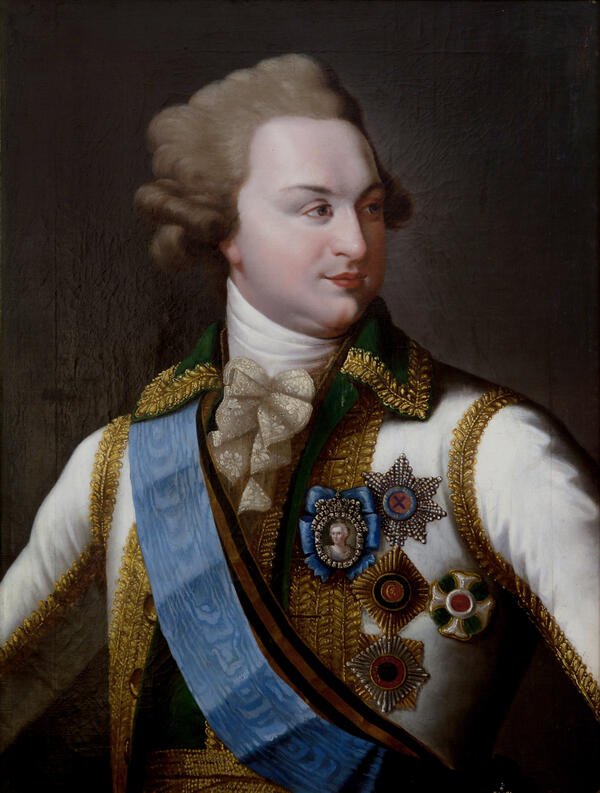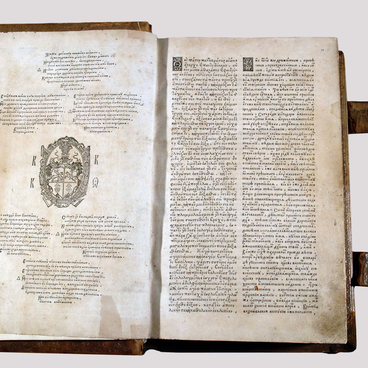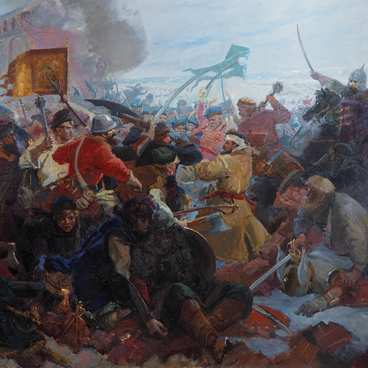Grigory Aleksandrovich Potemkin was born in the Chizhovo estate, Dukhovshchinsky district, Smolensk province. Even though his family was not rich, Grigory received a good education: first at the school of Johann-Philip Litke in the German settlement of Moscow, and then at the Moscow University. In 1761 Potemkin arrived in St. Petersburg and was promoted to sergeant in the Horse Guards.
Grigory Potemkin was an active participant in the palace coup on June 28, 1762, because of which Catherine II ascended the throne. For this he was promoted to sub-lieutenant. Potemkin diligently and successfully served both in the military and in the court line, but his star really rose during the Russian-Turkish war of 1768-1774.
In January 1769, the young chamberlain unexpectedly left Petersburg and went to the battle-ground as a volunteer with the rank of lieutenant. Grigory Alexandrovich especially distinguished himself during the siege of the Khotin fortress. ‘For his courage and experience in military affairs’ Potemkin at the age of 30 was awarded the rank of major general.
From January to September 1770 Potemkin took part in eight major battles against the Turks and was awarded the Orders of St. Anne and St. George of the 3rd degree. In December 1773, Catherine II wrote a warm letter to Grigory Alexandrovich, who was besieging the fortress of Silistria at that time. A lively correspondence began between them. Soon Potemkin found himself in the capital, where he became empress’ heartthrob.
In 1776, Potemkin was appointed governor-general of the Novorossiysk, Azov and Astrakhan provinces. Having become a high-ranking official, he took up the development of territories. Potemkin founded Yekaterinoslav, Alexander Fortress (now known as Zaporozhye), Mariupol and Kherson. Grigory Potemkin played a significant role in the annexation of Crimea by persuading the last Crimean khan Shahin Giray to voluntarily transfer his country to the sovereign hands of the Russian empress.
Potemkin was one of the founders of Russia’s main naval base in the Black Sea. For this purpose, the Akhtiyar Bay in the west of Crimea was chosen, which he called the Sevastopol refuge. He founded the cities of Simferopol, Melitopol, Nikolaev. Potemkin also supervised the journey of Catherine II to Novorossiya and the Crimea. Because of the trip, Catherine entitled His Serene Highness ‘Tauride’.
The last big affair of Grigory Alexandrovich was the Russian-Turkish war of 1787-1791, in which he successfully led the siege of the powerful Turkish fortress of Ochakov. After the fall of the fortress, Field Marshal Prince Grigory Alexandrovich Potemkin-Tavrichesky was awarded the Order of St. George of the 1stdegree.
According to experts, the Smolensk portrait of Potemkin is a copy of a painting by the artist von Lampi. The copy was probably made in the second half of the 19th century. Johann Baptiste von Lampi the Elder was an Austrian painter, graphic artist, master of ceremonial portrait. Von Lampi was extremely popular in Europe; many reigning persons considered it prestigious to order their ceremonial portrait from this master. In 1791, Grigory Alexandrovich Potemkin, who was then in Moldova, invited the artist to his headquarters in Jassy, where his portrait was created.
Grigory Potemkin was an active participant in the palace coup on June 28, 1762, because of which Catherine II ascended the throne. For this he was promoted to sub-lieutenant. Potemkin diligently and successfully served both in the military and in the court line, but his star really rose during the Russian-Turkish war of 1768-1774.
In January 1769, the young chamberlain unexpectedly left Petersburg and went to the battle-ground as a volunteer with the rank of lieutenant. Grigory Alexandrovich especially distinguished himself during the siege of the Khotin fortress. ‘For his courage and experience in military affairs’ Potemkin at the age of 30 was awarded the rank of major general.
From January to September 1770 Potemkin took part in eight major battles against the Turks and was awarded the Orders of St. Anne and St. George of the 3rd degree. In December 1773, Catherine II wrote a warm letter to Grigory Alexandrovich, who was besieging the fortress of Silistria at that time. A lively correspondence began between them. Soon Potemkin found himself in the capital, where he became empress’ heartthrob.
In 1776, Potemkin was appointed governor-general of the Novorossiysk, Azov and Astrakhan provinces. Having become a high-ranking official, he took up the development of territories. Potemkin founded Yekaterinoslav, Alexander Fortress (now known as Zaporozhye), Mariupol and Kherson. Grigory Potemkin played a significant role in the annexation of Crimea by persuading the last Crimean khan Shahin Giray to voluntarily transfer his country to the sovereign hands of the Russian empress.
Potemkin was one of the founders of Russia’s main naval base in the Black Sea. For this purpose, the Akhtiyar Bay in the west of Crimea was chosen, which he called the Sevastopol refuge. He founded the cities of Simferopol, Melitopol, Nikolaev. Potemkin also supervised the journey of Catherine II to Novorossiya and the Crimea. Because of the trip, Catherine entitled His Serene Highness ‘Tauride’.
The last big affair of Grigory Alexandrovich was the Russian-Turkish war of 1787-1791, in which he successfully led the siege of the powerful Turkish fortress of Ochakov. After the fall of the fortress, Field Marshal Prince Grigory Alexandrovich Potemkin-Tavrichesky was awarded the Order of St. George of the 1stdegree.
According to experts, the Smolensk portrait of Potemkin is a copy of a painting by the artist von Lampi. The copy was probably made in the second half of the 19th century. Johann Baptiste von Lampi the Elder was an Austrian painter, graphic artist, master of ceremonial portrait. Von Lampi was extremely popular in Europe; many reigning persons considered it prestigious to order their ceremonial portrait from this master. In 1791, Grigory Alexandrovich Potemkin, who was then in Moldova, invited the artist to his headquarters in Jassy, where his portrait was created.



